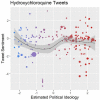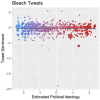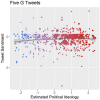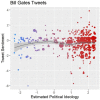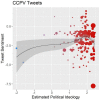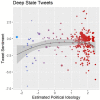Partisan public health: how does political ideology influence support for COVID-19 related misinformation?
- PMID: 33163686
- PMCID: PMC7604541
- DOI: 10.1007/s42001-020-00089-2
Partisan public health: how does political ideology influence support for COVID-19 related misinformation?
Abstract
This study analyzes over 4000 tweets related to six misinformation topics about the COVID-19 pandemic: the use of hydroxychloroquine as treatment, the use of bleach as a preventative measure, Bill Gates intentionally causing the virus, the Chinese Communist Party intentionally causing the virus, and the Deep State causing the virus to ruin the economy and threaten President Trump's reelection chances. Across 5 of 6 topics (excluding bleach), conservatives dominate the discourse on Twitter. Conservatives are also more likely than their liberal peers to believe in and push conspiracy theories that the Chinese Communist Party, Bill Gates, and the Deep State are working in conjunction to infect the population and enact a surveillance state. Pandemic related misinformation has previously been associated with decreased adherence to public health recommendations and adverse health effects and evidence from the current pandemic indicates that adherence to public health recommendations is starkly partisan. This study suggests that the political and informational polarization further facilitated by social media platforms such as Twitter may have dire consequences for public health.
Keywords: COVID-19; Political polarization; Sentiment analysis.
© Springer Nature Singapore Pte Ltd. 2020.
Conflict of interest statement
Conflicts of interestNo relevant disclosures.
Figures
Similar articles
- "Thought I'd Share First" and Other Conspiracy Theory Tweets from the COVID-19 Infodemic: Exploratory Study.JMIR Public Health Surveill. 2021 Apr 14;7(4):e26527. doi: 10.2196/26527.JMIR Public Health Surveill. 2021.PMID: 33764882Free PMC article.
- Constituents' Inferences of Local Governments' Goals and the Relationship Between Political Party and Belief in COVID-19 Misinformation: Cross-sectional Survey of Twitter Followers of State Public Health Departments.JMIR Infodemiology. 2022 Feb 10;2(1):e29246. doi: 10.2196/29246. eCollection 2022 Jan-Jun.JMIR Infodemiology. 2022.PMID: 37113808Free PMC article.
- A Dynamic Analysis of Conspiratorial Narratives on Twitter During the Pandemic.Cyberpsychol Behav Soc Netw. 2023 May;26(5):338-345. doi: 10.1089/cyber.2022.0218. Epub 2023 Mar 10.Cyberpsychol Behav Soc Netw. 2023.PMID: 36897292
- Partisan asymmetries in exposure to misinformation.Sci Rep. 2022 Sep 19;12(1):15671. doi: 10.1038/s41598-022-19837-7.Sci Rep. 2022.PMID: 36123387Free PMC article.
- COVID-19 Vaccine Hesitancy on Social Media: Building a Public Twitter Data Set of Antivaccine Content, Vaccine Misinformation, and Conspiracies.JMIR Public Health Surveill. 2021 Nov 17;7(11):e30642. doi: 10.2196/30642.JMIR Public Health Surveill. 2021.PMID: 34653016Free PMC article.
Cited by
- Using Twitter data to understand public perceptions of approved versus off-label use for COVID-19-related medications.J Am Med Inform Assoc. 2022 Sep 12;29(10):1668-1678. doi: 10.1093/jamia/ocac114.J Am Med Inform Assoc. 2022.PMID: 35775946Free PMC article.
- Sentimental Analysis of COVID-19 Tweets Using Deep Learning Models.Infect Dis Rep. 2021 Apr 1;13(2):329-339. doi: 10.3390/idr13020032.Infect Dis Rep. 2021.PMID: 33916139Free PMC article.
- Opinions on Homeopathy for COVID-19 on Twitter.Proc ACM Web Sci Conf. 2022 Jun;2022:359-363. doi: 10.1145/3501247.3531575. Epub 2022 Jun 26.Proc ACM Web Sci Conf. 2022.PMID: 36112977Free PMC article.
- The positive energy of netizens: development and application of fine-grained sentiment lexicon and emotional intensity model.Curr Psychol. 2022 Nov 3:1-18. doi: 10.1007/s12144-022-03876-4. Online ahead of print.Curr Psychol. 2022.PMID: 36345548Free PMC article.
- Estimating ideology and polarization in European countries using Facebook data.EPJ Data Sci. 2022;11(1):56. doi: 10.1140/epjds/s13688-022-00367-1. Epub 2022 Nov 22.EPJ Data Sci. 2022.PMID: 36466084Free PMC article.
References
- Nisbet EC, Cooper KE, Garrett RK. The partisan brain: How dissonant science messages lead conservatives and liberals to (dis) trust science. The ANNALS of the American Academy of Political and Social Science. 2015;658(1):36–66. doi: 10.1177/0002716214555474. - DOI
- Constantinou, M., Kagialis, A. & Karekla, M., (2020). Is science failing to pass its message to people? Reasons and risks behind conspiracy theories and myths regarding COVID-19. Reasons and risks behind conspiracy theories and myths regarding COVID-19 (April 16, 2020).
LinkOut - more resources
Full Text Sources



